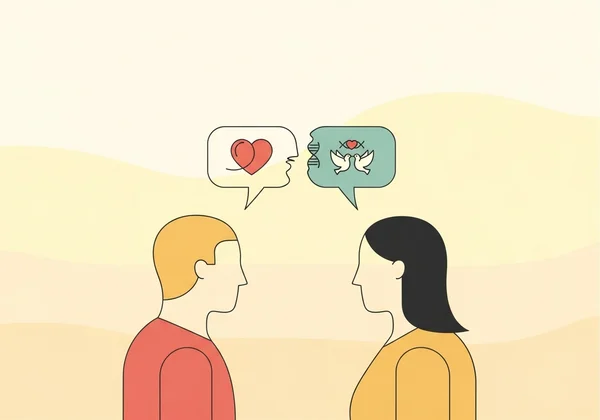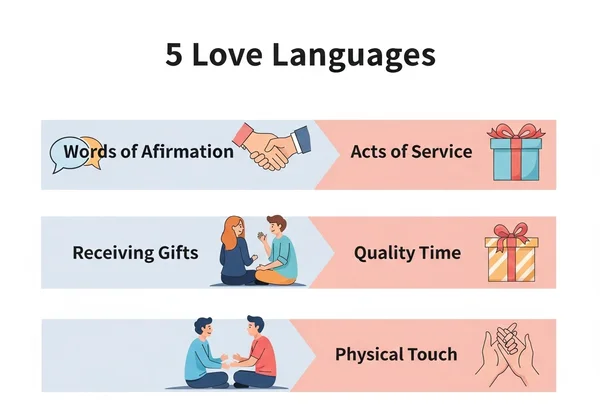Mismatched Love Languages? Your Guide to a Deeper Connection with the Love Language Test
Do you ever feel like you and your partner are speaking different languages, even when you’re both trying your best to show affection? You might be experiencing mismatched love languages. This is a common challenge where one person’s way of expressing love doesn’t align with how their partner receives it, leading to feelings of being unheard or unappreciated. What are the 5 love languages? Understanding this concept is the first step toward transforming your connection. This guide will explore why these differences exist and provide practical, empathetic strategies to bridge the gap, building a stronger, more meaningful relationship. The journey to better understanding begins with a single, simple step: discovering how you and your partner uniquely experience love through a love language test. You can find out your love language with our free quiz today.

Understanding Love Language Differences
The idea of love languages, introduced by Dr. Gary Chapman (learn more on his official website), isn't about diagnosing a problem in your relationship. Instead, it’s a powerful tool for building empathy and improving your emotional connection. When you feel a disconnect, it’s rarely because the love isn't there; it’s often because the love isn't being communicated in a way that resonates with your partner. Recognizing these differences is the key to connecting on a deeper level.
The 5 Love Languages: A Quick Review
To understand mismatches, we must first be clear on the five distinct ways people primarily express and feel love. This section serves as a quick guide to what you'll discover through a 5 love languages quiz. This framework is a great starting point for any relationship compatibility test.

- Words of Affirmation: This language uses words to build up the other person. Compliments, words of appreciation, and frequent "I love you's" make them feel cherished.
- Acts of Service: For these individuals, actions speak louder than words. Helping with chores, running errands, or offering a hand with a difficult task is a clear expression of love.
- Receiving Gifts: This isn’t about materialism. A person who values gifts sees them as tangible symbols of love, thought, and effort. The gift itself is a visual representation of affection.
- Quality Time: This language is all about giving your partner your undivided attention. No phones, no TV—just focused, intentional time together, listening and connecting.
- Physical Touch: For someone with this love language, nothing is more impactful than physical affection. Hugs, holding hands, and a comforting touch on the arm all communicate love directly.
Why Mismatches Occur (It's Not a Flaw!)
Having different love languages is completely normal and not a flaw in your relationship. These preferences are often shaped by our upbringing, past experiences, and innate personality. For example, if you grew up in a household where love was shown through providing and doing things, you might naturally develop Acts of Service as your primary language. If your partner grew up with verbally expressive parents, they might crave Words of Affirmation. A mismatch simply means you have a beautiful opportunity to learn more about each other and enhance your emotional connection.
The Impact of Unaddressed Love Language Gaps
When love language differences are ignored, feelings of frustration and resentment can build. The partner who speaks through Acts of Service might feel unappreciated for all they do, while the one who needs Quality Time feels lonely and unheard. This can lead to a cycle of misunderstanding: "I do so much for you, why aren't you happy?" meets "You're always busy doing things, but you never just sit with me." Breaking this cycle requires intentionally learning to speak a language that isn't your own.
Practical Strategies for Bridging Love Languages
The good news is that you don't need to be fluent in your partner's love language overnight. The goal is to make a conscious effort. Bridging love languages is about learning to translate your affection into actions your partner can truly feel and appreciate, creating a positive cycle of love and understanding.
Identifying Your Partner's Love Language & Your Own
The first, most crucial step is discovery. You can’t speak a language you don't know. How do you find out? You can observe what your partner requests most often, notice how they express love to you, or listen to their main complaints. However, the most direct and insightful way is to take a quiz together. Our 5 love languages quiz is designed to provide clear, actionable results for individuals and couples.
Speaking Their Language: Intentional Expression for Each Type
Once you know each other's primary languages, you can start making small, intentional changes. This is where you put your relationship needs into action.
- For Words of Affirmation: Send an unexpected text message praising them. Leave a sticky note on the mirror with a compliment. Be specific: instead of "You're great," try "I really admire how you handled that stressful situation today."
- For Acts of Service: Take a chore off their plate without being asked. Make them a cup of coffee in the morning. Ask, "Is there anything I can do to make your day easier?"
- For Receiving Gifts: Pick up their favorite snack on your way home. Find a small, thoughtful item that reminds you of them. Remember, it's the thought, not the price tag, that matters.
- For Quality Time: Schedule a "no-distractions" date night. Put your phones away during dinner. Go for a walk together and just talk.
- For Physical Touch: Hold their hand while watching a movie. Give them a hug before they leave for the day. Sit close to them on the couch.
Expressing Your Needs: How to Ask for the Love You Desire
Bridging the gap is a two-way street. It’s also important to gently and clearly communicate your own needs. Instead of saying, "You never spend time with me," try framing it positively: "I feel so loved and connected to you when we have uninterrupted time together. Could we plan for that this week?" This approach helps you work as a team, not against each other, and promotes healthy communication.
Cultivating Deeper Relationship Communication
Love languages are a fantastic tool, but they work best when integrated into a foundation of strong relationship communication. They are a conversation starter, not the entire conversation. True connection is built through ongoing dialogue, empathy, and a shared commitment to nurturing the relationship.

The Power of Open Dialogue & Regular Check-ins
Make it a habit to talk about what’s working. Have regular, low-pressure "relationship check-ins." You can ask questions like, "When did you feel most loved by me this week?" or "Is there anything I can do to help you feel more appreciated?" This kind of open dialogue keeps you both aligned and aware of each other's emotional state.
Compromise, Adaptation, and Mutual Effort
A healthy relationship requires mutual effort. It's not just about one person learning to speak their partner's language; it's about both partners stretching beyond their comfort zones. It means the Physical Touch person learns to offer praise, and the Words of Affirmation person learns to give a warm hug. This shared commitment is what truly strengthens your bond. Sometimes, the most powerful way to show love is by trying. Discovering your profiles is a great first step you can take together with a free love language test.
Beyond the Primary: Appreciating All Forms of Love
While everyone has a primary love language, it's important to remember that we all appreciate expressions of love from all five categories. Learning your partner's primary language helps you be more effective, but don't stop showing love in other ways. The goal is to build a rich, multi-faceted language of love that is unique to your relationship, one that ensures both partners feel consistently seen, valued, and cherished.
Your Journey to Deeper Connection Starts Here
Mismatched love languages are not a dead end; they are an invitation to grow closer. By understanding the five love languages, identifying your own and your partner's, and committing to speaking their language intentionally, you can bridge any gap. You can transform misunderstandings into moments of connection and build a relationship that is more resilient, empathetic, and deeply fulfilling.
Ready to take that first step? Stop guessing and start understanding. Take our free love language test today to discover your unique love language profile and begin your journey toward a more connected relationship.

Frequently Asked Questions About Love Language Mismatches
Do love languages have to match for a couple to be happy?
Absolutely not! In fact, very few couples have perfectly matching love languages. Happiness in a relationship comes from understanding, empathy, and the willingness to learn and adapt to each other's needs. A mismatch is simply an opportunity to love your partner more intentionally.
How can I discover my partner's love language without asking directly?
Observation is key. Listen to what they complain about most often (e.g., "We never spend time together" hints at Quality Time). Notice how they show love to you and others, as people tend to give love in the way they'd like to receive it. Of course, the easiest and most accurate way is to take this insightful test together.
Can a person's primary love language change over time?
Yes, it can. Major life events like having children, changing careers, or going through a difficult time can shift our emotional needs. For example, a new parent might suddenly value Acts of Service more than ever before. This is why regular communication and check-ins are so important for long-term relationship health.
What if my partner isn't interested in learning about love languages?
You can't force your partner to be interested, but you can lead by example. Start by learning their love language and expressing love to them in that way without expecting anything in return. When they start to feel more loved and understood, their curiosity might naturally grow. The positive change they feel can be the most convincing argument.